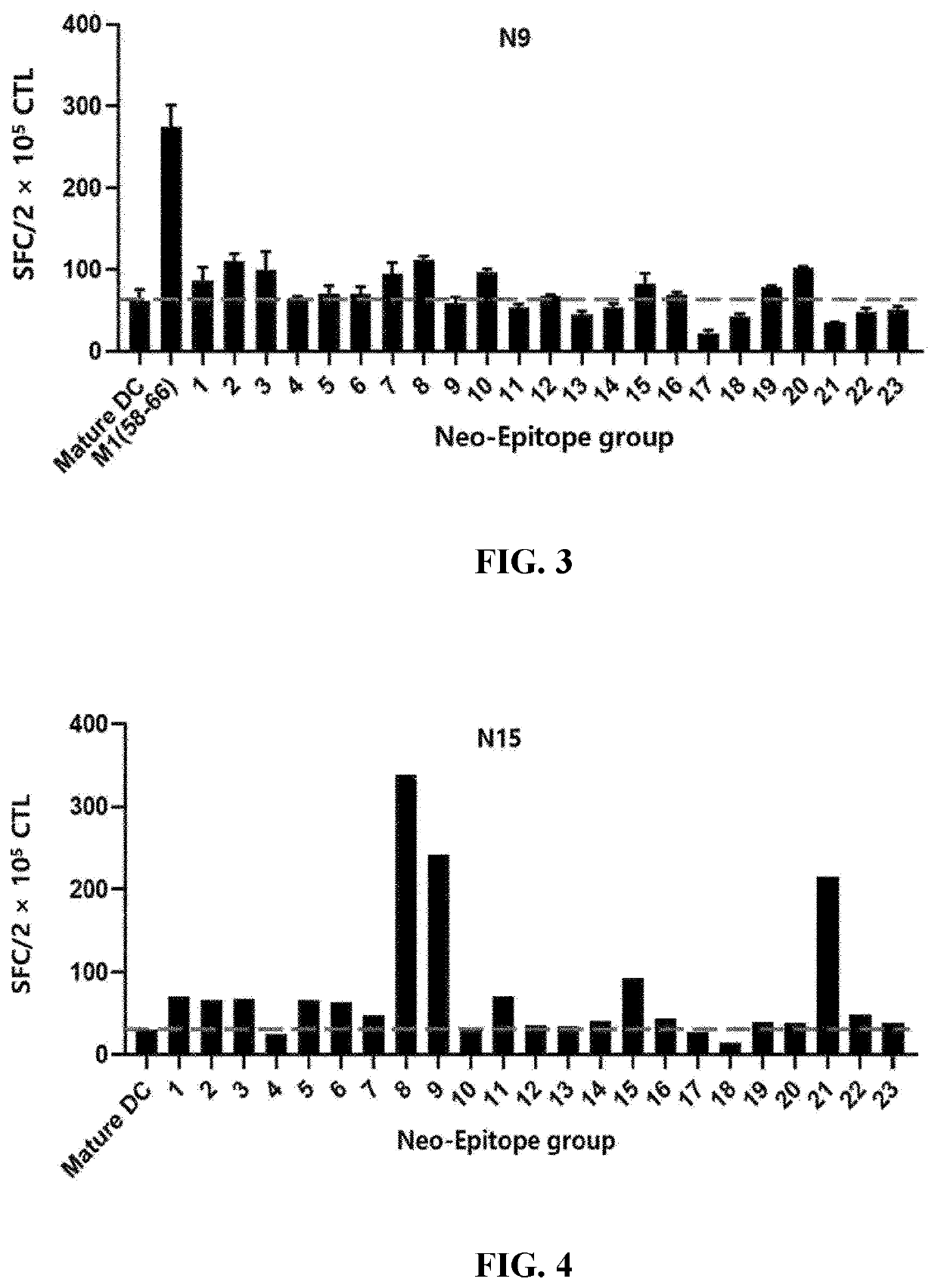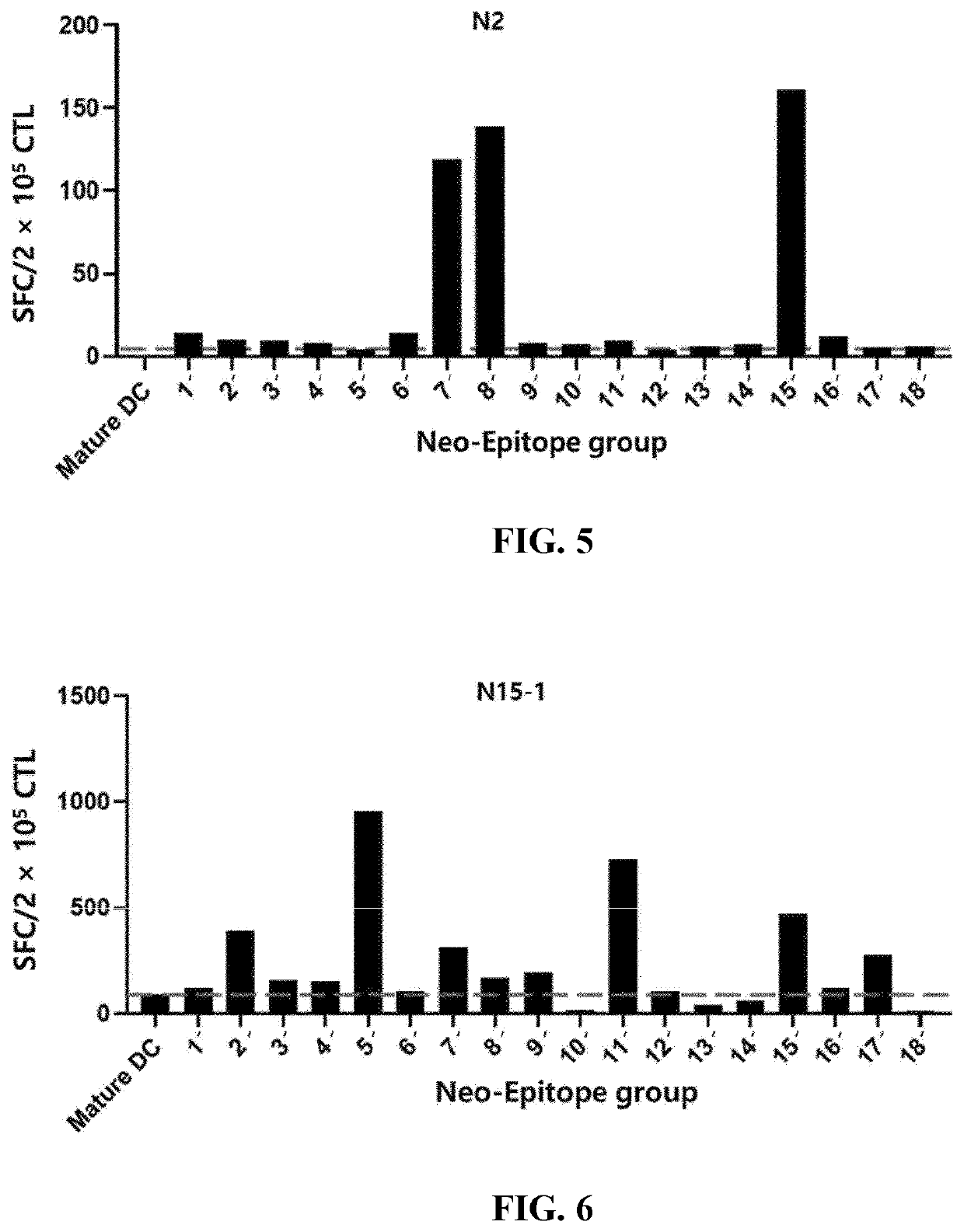Method for t cell activation for cancer treatment
a cancer and t cell technology, applied in the field of cancer-specific tumor antigen epitope, can solve the problems of difficult-to-cure gastric cancer, unreported therapeutic agents with good clinical effects, and several side effects, so as to avoid the defense mechanism of cancer cells, prevent recurrence, progression or metastasis of cancer, and induce differentiation and proliferation rapid and effective
- Summary
- Abstract
- Description
- Claims
- Application Information
AI Technical Summary
Benefits of technology
Problems solved by technology
Method used
Image
Examples
example 2
[Example 2] ELISPOT Results for T Cells Activated by Dendritic Cells Loaded with Selected LMP2a Epitope
[0104]PBMCs extracted from the blood of three healthy humans (N5, N9, or N15) were separated into monocytes and leukocytes through magnetic-activated cell sorting, and the monocytes were cultured for 4 days in a culture supplemented with cytokines GM-CSF and IL-4 to differentiate into dendritic cells. To the culture, in which the monocytes had differentiated into dendritic cells, was added each group containing 10 or 11 epitope peptides as set forth in Table 3 together with poly(I:C) so that the respective peptides were transferred to the dendritic cells. The culture was matured for 1 day. In addition, the leukocytes were cultured for 3 days in a culture supplemented with anti-CD3 / CD28 antibodies and cytokine IL-2.
TABLE 3GroupSEQ ID NO1SEQ ID NO: 1, SEQ ID NO: 13, SEQ ID NO: 25, SEQ ID NO: 37, SEQ ID NO: 49, SEQ ID NO: 61, SEQ ID NO: 73, SEQ ID NO: 85, SEQ ID NO: 97, SEQ ID NO: 109...
example 3
[Example 3] ELISPOT Results for T Cells Activated with Dendritic Cells Loaded with Selected EBNA-1 Epitope
[0110]Using PBMCs extracted from the blood of three healthy humans (N2, N15, or N19), the degree of T cell activation was checked in the same manner as in Example 2, and the results are illustrated in FIGS. 5 to 8. Here, the monocytes having differentiated into dendritic cells were transformed with each group containing 10 or 11 epitope peptides as set forth in Table 4.
TABLE 4GroupSEQ ID NO 1′SEQ ID NO: 123, SEQ ID NO: 132, SEQ ID NO: 141, SEQ ID NO: 150, SEQ ID NO: 159, SEQ ID NO: 168, SEQ ID NO: 177, SEQ ID NO: 186, SEQ ID NO: 195 2′SEQ ID NO: 124, SEQ ID NO: 133, SEQ ID NO: 142, SEQ ID NO: 151, SEQ ID NO: 160, SEQ ID NO: 169, SEQ ID NO: 178, SEQ ID NO: 187, SEQ ID NO: 196 3′SEQ ID NO: 125, SEQ ID NO: 134, SEQ ID NO: 143, SEQ ID NO: 152, SEQ ID NO: 161, SEQ ID NO: 170, SEQ ID NO: 179, SEQ ID NO: 188, SEQ ID NO: 197 4′SEQ ID NO: 126, SEQ ID NO: 135, SEQ ID NO: 144, SEQ ID NO: 1...
PUM
| Property | Measurement | Unit |
|---|---|---|
| time | aaaaa | aaaaa |
| time | aaaaa | aaaaa |
| time | aaaaa | aaaaa |
Abstract
Description
Claims
Application Information
 Login to View More
Login to View More - R&D
- Intellectual Property
- Life Sciences
- Materials
- Tech Scout
- Unparalleled Data Quality
- Higher Quality Content
- 60% Fewer Hallucinations
Browse by: Latest US Patents, China's latest patents, Technical Efficacy Thesaurus, Application Domain, Technology Topic, Popular Technical Reports.
© 2025 PatSnap. All rights reserved.Legal|Privacy policy|Modern Slavery Act Transparency Statement|Sitemap|About US| Contact US: help@patsnap.com



